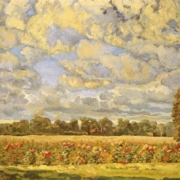Then,’ the gardener went on, ‘to the right the valley opens up and you can see across the meadows and trees and far into the distance (J.W. Goethe, Die Wahlverwandtschaften , trad. Eng. Elective Affinities)
There is more sky than earth in Bion’s landscapes in an open space and built by horizontal planes, but he gives imposing prevailing images and enables the spectator to have the freedom to follow him directly everywhere.
Looking is not restricted, has perspective points of escape, starts from the border of the painting, penetrating into a landscape, mindful of the experience of the landscape gardening, where the mastery of the different Charles Bridgeman (1680-1738), William Kent (1684-1748), un Lancelot Brown (1715-1783), is used to √create surroundings beyond the architectural geometry of Italian gardening, becoming larger without any solution of century, from the foreground of flowers and bushes, to the remoteness of fields and dark shadows of woods above the horizon, in order to give up the infinity of the sky and the passage of clouds and the passage of clouds.
From the veiled reminiscence of John Constable’s (1776-1837) atmospheres, the movement of clouds in the sky, real hero of Bion’s creation : it acts as a counterpoint to the quietness of fields and invites to reflect on the process of continuous transformation of forms.

